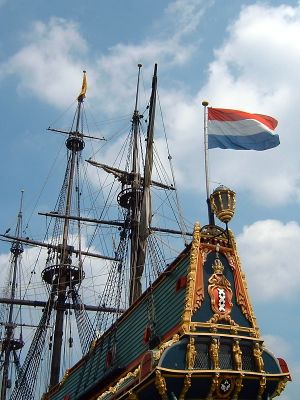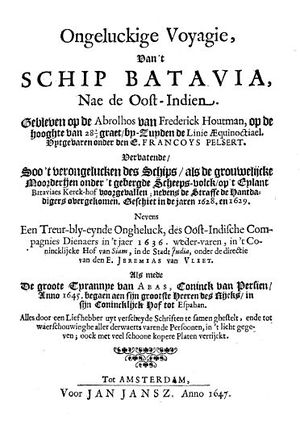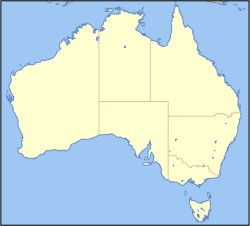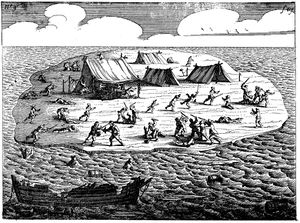Batavia (ship)
 Ship replica of the Batavia | |
| Career (Dutch Republic) | |
|---|---|
| Name: | Batavia |
| Namesake: | Settlement Batavia |
| Owner: |
Dutch East India Company Chamber of Amsterdam |
| Completed: | 1628 |
| Fate: | Wrecked on the Houtman Abrolhos on 4 June 1629 |
| General characteristics | |
| Type: | Fluyt |
| Tonnage: | 650 tons |
| Displacement: | Circa 1200 tons |
| Length: | 56.6 metres (186 ft) |
| Beam: | 10.5 metres (34 ft) |
| Height: | 55 metres (180 ft) |
| Draught: | 5.1 metres (17 ft) |
| Propulsion: | Sails (1180 m2) |
| Crew: | 341 men (incl. passengers) |
| Armament: | 24 cast-iron cannons |
Batavia was a ship of the Dutch East India Company (VOC). It was built in Amsterdam in 1628, and armed with 24 cast-iron cannons. Batavia was shipwrecked on her maiden voyage, and was made famous by the subsequent mutiny and massacre that took place among the survivors. A twentieth century replica of the ship is also called the Batavia and can be visited in Lelystad, Netherlands.
Contents
Mutiny on the Batavia
Departure
On 28 October 1628, the newly built Batavia, commissioned by the Dutch East India Company, sailed from Texel[1] for the Dutch East Indies, to obtain spices. It sailed under commandeur and opperkoopman (upper- or senior merchant) Francisco Pelsaert, with Ariaen Jacobsz serving as skipper. These two had previously encountered each other in Surat, India. Although some animosity had developed between them there, it is not known whether Pelsaert even remembered Jacobsz when he boarded Batavia. Also on board was the onderkoopman (under- or junior merchant) Jeronimus Cornelisz, a bankrupt pharmacist from Haarlem who was fleeing the Netherlands, in fear of arrest because of his heretical beliefs associated with the painter Johannes van der Beek, also known as Torrentius.
Plot begins
During the voyage, Jacobsz and Cornelisz conceived a plan to take the ship, which would allow them to start a new life somewhere, using the huge supply of trade gold and silver then on board. After leaving Cape Town, where they had stopped for supplies, Jacobsz deliberately steered the ship off course, away from the rest of the fleet. Jacobsz and Cornelisz had already gathered a small group of men around them and arranged an incident from which the mutiny was to ensue. This involved molesting a high-ranking young female passenger, Lucretia Jans, in order to provoke Pelsaert into disciplining the crew. They hoped to paint his discipline as unfair and recruit more members out of sympathy. However, the woman was able to identify her attackers [1]. The mutineers were then forced to wait until Pelsaert made arrests, but he never acted.
Shipwrecked
On 4 June 1629 the ship struck a reef near Beacon Island (28°29′25″S 113°47′36″E / 28.49028°S 113.79333°ECoordinates: 28°29′25″S 113°47′36″E / 28.49028°S 113.79333°E), part of the Houtman Abrolhos off the Western Australian coast.[1] Of the 322 aboard, most of the passengers and crew managed to get ashore, although 40 people drowned. The survivors, including all the women and children, were then transferred to nearby islands in the ship's longboat and yawl. An initial survey of the islands found no fresh water and only limited food (sea lions and birds). Pelsaert realised the dire situation and decided to search for water on the mainland.
Going for help
A group comprising Captain Jacobsz, Francisco Pelsaert, senior officers, a few crewmembers, and some passengers left the wreck site in a 30-foot (9.1 m) longboat (a replica of which has also been made), in search of drinking water. After an unsuccessful search for water on the mainland, they abandoned the other survivors and headed north in a danger-fraught voyage to the city of Batavia, now known as Jakarta. This journey, which ranks as one of the greatest feats of navigation in open boats, took 33 days and, extraordinarily, all aboard survived.
After their arrival in Batavia, the boatswain, a man named Jan Evertsz, was arrested and executed for negligence and "outrageous behaviour" before the loss of the ship (he was suspected to have been involved). Jacobsz was also arrested for negligence, although his position in the potential mutiny was not guessed by Pelsaert.
Batavia's Governor General, Jan Coen, immediately gave Pelsaert command of the Sardam to rescue the other survivors, as well as to attempt to salvage riches from the Batavia's wreck. He arrived at the islands two months after leaving Batavia, only to discover that a bloody mutiny had taken place amongst the survivors, reducing their numbers by at least a hundred.
Murder
Jeronimus Cornelisz, who had been left in charge of the survivors, was well aware that if that party ever reached the port of Batavia, Pelsaert would report the impending mutiny, and his position in the planned mutiny might become apparent. Therefore, he made plans to hijack any rescue ship that might return and use the vessel to seek another safe haven. Cornelisz even made far-fetched plans to start a new kingdom, using the gold and silver from the wrecked Batavia. However, to carry out this plan, he first needed to eliminate possible opponents.[2]
Cornelisz's first deliberate act was to have all weapons and food supplies commandeered and placed under his control. He then moved a group of soldiers, led by Wiebbe Hayes, to nearby West Wallabi Island, under the false pretence of searching for water. They were told to light signal fires when they found water and they would then be rescued.[2] Convinced that they would be unsuccessful, he then left them there to die.
Cornelisz then had complete control. The remaining survivors would face two months of unrelenting butchery and savagery.
With a dedicated band of murderous young men, Cornelisz began to systematically kill anyone he believed would be a problem to his reign of terror, or a burden on their limited resources. The mutineers became intoxicated with killing, and no one could stop them. They needed only the smallest of excuses to drown, bash, strangle or stab to death any of their victims, including women and children.[2]
Cornelisz never committed any of the murders himself, although he tried and failed to strangle a baby. Instead, he used his powers of persuasion to coerce others into doing it for him, firstly under the pretence that the victim had committed a crime such as theft. Eventually, the mutineers began to kill for pleasure, or simply because they were bored. He planned to reduce the island's population to around 45 so that their supplies would last as long as possible. Between them, his followers murdered at least 110 men, women, and children.
|
Location of the wreck of the Batavia |
Help returns
Although Cornelisz had left the soldiers, led by Wiebbe Hayes, to die, they had in fact found good sources of water and food on their islands. Initially, they did not know of the barbarity taking place on the other islands and still sent pre-arranged smoke signals announcing their finds. However, they soon learned of the massacres from survivors fleeing Cornelisz' island. The soldiers put together makeshift weapons from materials washed up from the wreck. They also set a watch so that they were ready for the mutineers, and built a small fort out of limestone and coral blocks.
Cornelisz seized on the news of water on the other island as his own supply was dwindling and the continued survival of the soldiers threatened his own success. He went with his men to try and defeat the soldiers marooned on West Wallabi Island. However, the trained soldiers were by now much better fed than the mutineers and easily defeated them in several battles, eventually taking Cornelisz hostage. The mutineers who escaped regrouped under a man named Wouter Loos and tried again, this time employing muskets to besiege Hayes' fort and almost defeated the soldiers.
But Wiebbe Hayes' men prevailed again just as Pelsaert arrived. A race to the rescue ship ensued between Cornelisz's men and the soldiers. Wiebbe Hayes reached the ship first and was able to present his side of the story to Pelsaert. After a short battle, the combined force captured all of the mutineers.
Aftermath
Pelsaert decided to conduct a trial on the islands, because the Saardam on the return voyage to Batavia would have been overcrowded with survivors and prisoners. After a brief trial, the worst offenders were taken to Seals' Island and executed. Cornelisz and several of the major mutineers had both hands chopped off before being hanged.[3] Wouter Loos and a cabin boy, considered only minor offenders, were marooned on mainland Australia, never to be heard of again. Reports of unusually light-skinned Aborigines in the area by later British settlers have been suggested as evidence that the two men might have been adopted into a local Aboriginal clan.[citation needed] However, numerous other European shipwreck survivors, such as those from the wreck of the Zuytdorp in the same region in 1712, may also have had such contact with indigenous inhabitants.
The remaining mutineers were taken to Batavia for trial. Five were hanged, while several others were flogged. Cornelisz's second in command, Jacop Pietersz, was broken on the wheel, the most severe punishment available at the time.
Captain Jacobsz, despite being tortured, did not confess to his part in planning the mutiny and escaped execution due to lack of evidence. What finally became of him is unknown. It is suspected that he died in prison in Batavia.
A board of inquiry decided that Pelsaert had exercised a lack of authority and was therefore partly responsible for what had happened. His financial assets were seized and he died a broken man within a year.
On the other hand, the common soldier Wiebbe Hayes was hailed a hero. The VOC promoted him to sergeant, and later to lieutenant, which increased his salary fivefold.
Of the original 341 people on board Batavia, only 68 made it to the port of Batavia.
The wreckage
During Admiralty surveys of the Abrolhos Islands on the north-west coast in April 1840, Captain Stokes of the HMS Beagle reported that:
On the south west point of an island the beams of a large vessel were discovered, and as the crew of the Zeewyk, lost in 1728, reported having seen a wreck of a ship on this part, there is little doubt that the remains were those of the Batavia, Commodore Pelsart, lost in 1627. We in consequence named our temporary anchorage Batavia Road, and the whole group Pelsart Group.[3]
However, Stokes may have confused the wreck of the Zeewyk for that of the Batavia.[citation needed]
In 1970, the Batavia wreck and many artifacts were salvaged, including the stern of the ship. In 1972 the Netherlands transferred all rights to Dutch shipwrecks on the Australian coasts to Australia. Some of the items, including human remains, which were excavated, are now on display in the Western Australian Museum - Shipwreck Galleries in Fremantle, Australia. Others are held by the Western Australian Museum - Geraldton. These two museums presently share the remains: a replica stone arch is held in The Western Australian Museum - Shipwreck Galleries, which was intended to serve as a stone welcome arch for the city of Batavia and the actual stone arch is held in the Western Australian Museum - Geraldton; the original timber is held at the Western Australian Museum - Shipwreck Galleries, and a replica is found at Geraldton.
The replica

A replica of the Batavia was built at the Bataviawerf (Batavia Wharf) in Lelystad in the Netherlands. The project lasted from 1985 to 7 April 1995, and was conducted as an employment project for young people under master-shipbuilder Willem Vos. The shipyard is currently reconstructing another 17th century ship. In contrast to the merchant ship Batavia, Michiel de Ruyters' flagship, the Zeven Provinciën, is a ship of the line.
The Batavia replica was built with traditional materials, such as oak and hemp, and using the tools and methods of the time of the original ship's construction. For the design, good use was made of the remains of the original ship in Fremantle (and of the Vasa in Stockholm), as well as historical sources, such as 17th century building descriptions (actual building plans weren't made at the time), and prints and paintings by artists (who, at the time, generally painted fairly true to nature), of similar ships.
On 25 September 1999, the new Batavia was transported to Australia by barge, and moored at the National Maritime Museum in Sydney. In 2000, Batavia was the flagship for the Dutch Olympic Team during the 2000 Olympic Games. During its stay in Australia, the ship was towed to the ocean once, where it sailed on its own. On 12 June 2001, the ship returned to the Bataviawerf in Lelystad, where it remains on display to visitors. On the evening of October 13 2008 a fire ripped through the Batavia-werf. Although the sailmaking shed, several office buildings and part of a restaurant were destroyed, as were the sails of replica ship Batavia, the replica of "De Zeven Provinciën" nearby was undamaged. The Batavia was never in danger.
Publications and other media

The following list is selective - the fascination with the wreck of Batavia has created an industry - with many other books and articles written, besides the items shown below.
- 1647 - Commander Pelsaert died the year after the event, leaving behind his journal of the events. This journal, together with the pamphlet Ongeluckige voyagie van 't schip Batavia (The Unlucky Voyage of the Vessel Batavia), published in 1647, made it possible to rediscover the wreck.
- 1897 - Willem Siebenhaar's The Abrolhos tragedy, a translation of Ongeluckige voyagie, was published in the Western Mail. The events also formed the basis of a novel called Marooned on Australia (?1896), by the explorer Ernest Favenc. The events were to feature in Malcolm Uren's work Sailorman's ghosts (1940), and Douglas Stewart's radio play Shipwrecked, in 1947.
- 1963 - Renowned Australian author Henrietta Drake-Brockman's comprehensive, non-fiction account Voyage to Disaster took her ten years to write. She also wrote a fictional story based on the Batavia, The Wicked and the Fair in 1957. It was Drake-Brockman's own research (including calculating the differences between Dutch nautical miles from the early 17th century, and English nautical miles) that led divers to the location of the wreck.
- 1966 - Journalist Hugh Edwards published an account of the shipwreck and its rediscovery by Dave Johnson, Max and Gerard Cramer, and Greg Allen, under the name Island of Angry Ghosts: Murder, Mayhem and Mutiny (1966).
- 1970s and 80s - The tale was retold by a number of writers, including Lee Knowles 'Batavia incident' in Cool Summers, Hal Colebatch's 'Batavia suite', Mark O'Connor's poem sequence 'the Batavia' and in Nicholas Hasluck's, The Bellarmine Jug.
- 1990 - Deborah Lisson's book The Devil's Own, which is aimed at young adults, is also based on the events of Batavia mutiny and massacre. This book won the Western Australian Premier's Award in 1991.
- 1991 - A sub-plot in Gary Crew's novel Strange Objects included two men who sailed Batavia, Wouter Loos, and Jan Pelgrom.
- 1993 - Philippe Godard's book The First and Last Voyage of the Batavia provides a wealth of illustrations, along with details of Batavia's construction, objectives and, of course, the traumatic events on the islands off the West Australian coast. At the end of the book is an English translation of Pelsaert's pamphlet regarding the events on Batavia. The construction of Batavia's second incarnation is also covered, with a number of detailed photographs of the new ship.
- 1995 - Prospero Productions made a 52 minute documentary entitled "Batavia Wreck, mutiny and murder", filmed on location.
- 2000 - Arabella Edge's novel The Company is also based on the events of 1629, as is Kathryn Heyman's novel The Accomplice (2003). Whereas Edge tells the story from the perspective of Cornelisz, the chief mutineer, Heyman's The Accomplice is based on the predicament of Judith Bastiaansz, the Predikant's daughter.
- 2000 - The story was also told in a one-hour radio drama, Southland, written by D. J. Britton and broadcast in September 2000 on BBC Radio 4.
- 2001 - The story was retold in the form of an acclaimed opera, simply titled Batavia, composed by Richard Mills and first performed by Opera Australia.
- 2002 - Architect Frits van Dongen, graphic designer Kees Nieuwenhuijzen, and poet Gerrit Kouwenaar built an apartment complex in Amsterdam named Batavia, with a poem referencing the ship imprinted into a wall of the building.[4]
- 2002 - Historian Mike Dash's book, Batavia's Graveyard: The True Story of the Mad Heretic Who Led History's Bloodiest Mutiny, told the whole story in more detail than ever before, making extensive use of Dutch archival sources to explore the early life of Cornelisz, and a number of the Batavia's other passengers and crew.
- 2006 - Writer Simon Leys published The Wreck of the Batavia: A True Story, relating the fate of the Batavia and her crew. The French version of this book, Les Naufragés du Batavia (2003), won the Guizot Prize.
- 2010 - Writer Greta van der Rol published Die a Dry Death, a historical novel based on the true events of the wreck of the Batavia. It makes an argument for the innocence of the captain of the ship, Adriaen Jacobsz. (2010)
Notes
- ↑ 1.0 1.1 "Registration Information for: Batavia". The Department of Maritime Archaeology Online Databases. Western Australian Museum. http://www.museum.wa.gov.au/collections/databases/maritime/shipwrecks/shipdetail.asp?ID=1316&Shipname=batavia&Shipdate=&Range1=&Range2=&Shiptype=&Discovered=%&Region=0. Retrieved 2007-09-11.
- ↑ 2.0 2.1 2.2 "Batavia's Graveyard". Houtman Albrolhos. Perth: VOC Historical Society. 2008. http://www.voc.iinet.net.au/batavia.html. Retrieved 2009-12-31.
- ↑ 3.0 3.1 Kimberly, W.B. (compiler) (1897). History of West Australia. A Narrative of her Past. Together With Biographies of Her Leading Men. Melbourne: F.W. Niven. p.10
- ↑ ArchiNed Nieuws, website related to the 'Batavia' apartment building in Amsterdam, accessed 3 December 2007.
References
- Balkan, Evan. Shipwrecked! Deadly Adventures and Disasters at Sea. Birmingham, AL: Menasha Ridge, 2008, pp. 68-78
- Crew, Gary. Strange Objects Port Melbourne, Vic. : Mammoth Australia, 1991. ISBN 1-86330-113-5
- Dash, Mike. Batavia's graveyard London : Weidenfeld & Nicolson, 2002. ISBN 0-575-07024-2
- Drake-Brockman, Henrietta. Voyage to Disaster (new edition with new introduction) Western Australia : University of Western Australia Press, 1995. ISBN 1-875560-32-7
- Edge, Arabella. The company : the story of a murderer Sydney : Picador, 2000 ISBN 0-330-48978-X
- Edwards, Hugh, Islands of angry ghosts London : Hodder & Stoughton, 1966
- Godard, Philippe. The first and last voyage of the Batavia ( with the contribution of Phillida Stephens.) Perth, W.A : Abrolhos Publishing 1993. ISBN 0-646-10519-1
- Lisson, Deborah.The devil's own Port Melbourne, Vic. : Lothian, 2000.(First ed.: Glebe, N.S.W. : Walter McVitty, 1990) ISBN 0-7344-0128-0
- Leys, Simon The wreck of the Batavia; &, Prosper Melbourne : Black Inc., 2005. ISBN 1-86395-150-4
External links
| Batavia (ship)
]]| Wikisource has original text related to this article: |
- The Batavia Story, a detailed account of the mutiny
- Batavia yard, where the replica was built and is now moored
- Pelsaert, Batavia, 1629 Facsimile of . Ongeluckige voyagie, van't schip Batavia, nae de Oost-Indien [Pelsaert Journal].
- Batavia Model Ship, a scaled replica of the replica.
| 17th century shipwrecks in Australia | ||
|---|---|---|
| Tryall | 't Wapen van Hoorn | Vianen | Batavia | Vergulde Draeck | Goede Hoop's boat | Waeckende Boey's jawl | Ridderschap van Holland | ||
ar:باتافيا de:Batavia (Schiff) fr:Batavia (bateau) it:Batavia (nave) la:Batavia (navis) nl:Batavia (schip) pl:Batavia (statek) fi:Batavia (laiva)
- Pages using invalid self-closed HTML tags
- All articles with unsourced statements
- Articles with unsourced statements from January 2008
- Articles with invalid date parameter in template
- Pages with broken file links
- Articles with unsourced statements from October 2008
- Batavia (ship)
- Replica ships
- Shipwrecks of Western Australia
- Maritime incidents in 1629
- 1620s ships




